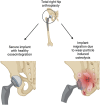The Microbial Revolution in the World of Joint Replacement Surgery
- PMID: 38638595
- PMCID: PMC11023614
- DOI: 10.2106/JBJS.OA.23.00153
The Microbial Revolution in the World of Joint Replacement Surgery
Abstract
Background: The prevalence of revision surgery due to aseptic loosening and periprosthetic joint infection (PJI) following total hip and knee arthroplasty is growing. Strategies to prevent the need for revision surgery and its associated health-care costs and patient morbidity are needed. Therapies that modulate the gut microbiota to influence bone health and systemic inflammation are a novel area of research.
Methods: A literature review of preclinical and clinical peer-reviewed articles relating to the role of the gut microbiota in bone health and PJI was performed.
Results: There is evidence that the gut microbiota plays a role in maintaining bone mineral density, which can contribute to osseointegration, osteolysis, aseptic loosening, and periprosthetic fractures. Similarly, the gut microbiota influences gut permeability and the potential for bacterial translocation to the bloodstream, increasing susceptibility to PJI.
Conclusions: Emerging evidence supports the role of the gut microbiota in the development of complications such as aseptic loosening and PJI after total hip or knee arthroplasty. There is a potential for microbial therapies such as probiotics or fecal microbial transplantation to moderate the risk of developing these complications. However, further investigation is required.
Clinical relevance: Modulation of the gut microbiota may influence patient outcomes following total joint arthroplasty.
Copyright © 2024 The Authors. Published by The Journal of Bone and Joint Surgery, Incorporated. All rights reserved.
Conflict of interest statement
Disclosure: Funding for this study was provided by an Arthritis Society of Canada Stars Career Development Award and the Schulich School of Medicine & Dentistry Summer Research Training Program. The Article Processing Charge for open access publication was funded by the Arthritis Society. The Disclosure of Potential Conflicts of Interest forms are provided with the online version of the article (http://links.lww.com/JBJSOA/A623).
Figures



Similar articles
-
High Rates of Aseptic Loosening After Revision Total Knee Arthroplasty for Periprosthetic Joint Infection.JB JS Open Access. 2020 Aug 12;5(3):e20.00026. doi: 10.2106/JBJS.OA.20.00026. eCollection 2020 Jul-Sep. JB JS Open Access. 2020. PMID: 32984749 Free PMC article.
-
Disruption of the Gut Microbiome Increases the Risk of Periprosthetic Joint Infection in Mice.Clin Orthop Relat Res. 2019 Nov;477(11):2588-2598. doi: 10.1097/CORR.0000000000000851. Clin Orthop Relat Res. 2019. PMID: 31283731 Free PMC article.
-
Risk of Prosthetic Joint Infection Increases Following Early Aseptic Revision Surgery of Total Hip and Knee Arthroplasty.J Arthroplasty. 2020 Dec;35(12):3661-3667. doi: 10.1016/j.arth.2020.06.089. Epub 2020 Jul 3. J Arthroplasty. 2020. PMID: 32712119
-
Preoperative Opioid Use Is Associated With Higher Revision Rates in Total Joint Arthroplasty: A Systematic Review.J Arthroplasty. 2021 Nov;36(11):3814-3821. doi: 10.1016/j.arth.2021.06.017. Epub 2021 Jun 24. J Arthroplasty. 2021. PMID: 34247870
-
Diagnostic Criteria and Treatment of Acute and Chronic Periprosthetic Joint Infection of Total Ankle Arthroplasty.Foot Ankle Orthop. 2019 Apr 30;4(2):2473011419841000. doi: 10.1177/2473011419841000. eCollection 2019 Apr. Foot Ankle Orthop. 2019. PMID: 35097323 Free PMC article. Review.
References
-
- Sloan M, Premkumar A, Sheth NP. Projected Volume of Primary Total Joint Arthroplasty in the U.S., 2014 to 2030. J Bone Joint Surg Am. 2018. Sep 5;100(17):1455-60. - PubMed
-
- Canadian Institute for Health Information. CJRR annual report: Hip and knee replacements in Canada. Accessed 2023 Jun 19. https://www.cihi.ca/en/cjrr-annual-report-hip-and-knee-replacements-in-c....
-
- Hunter DJ, Bierma-Zeinstra S. Osteoarthritis. Lancet. 2019. Apr 27;393(10182):1745-59. - PubMed
-
- Hunter DJ, Schofield D, Callander E. The individual and socioeconomic impact of osteoarthritis. Nat Rev Rheumatol. 2014. Jul;10(7):437-41. - PubMed
-
- Delanois RE, Mistry JB, Gwam CU, Mohamed NS, Choksi US, Mont MA. Current Epidemiology of Revision Total Knee Arthroplasty in the United States. J Arthroplasty. 2017. Sep;32(9):2663-8. - PubMed
LinkOut - more resources
Full Text Sources
